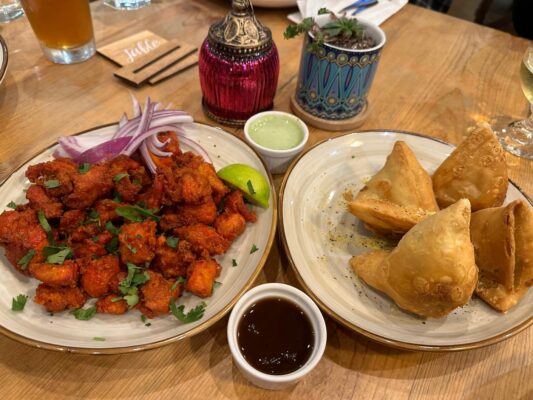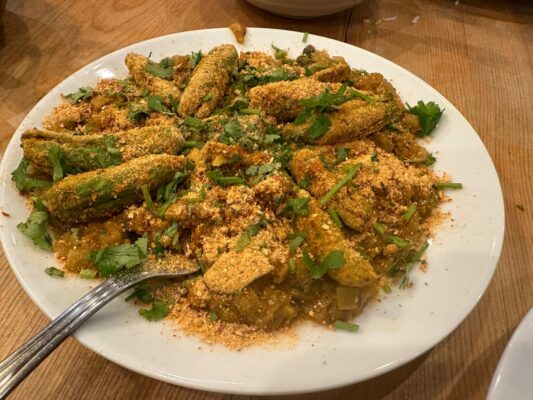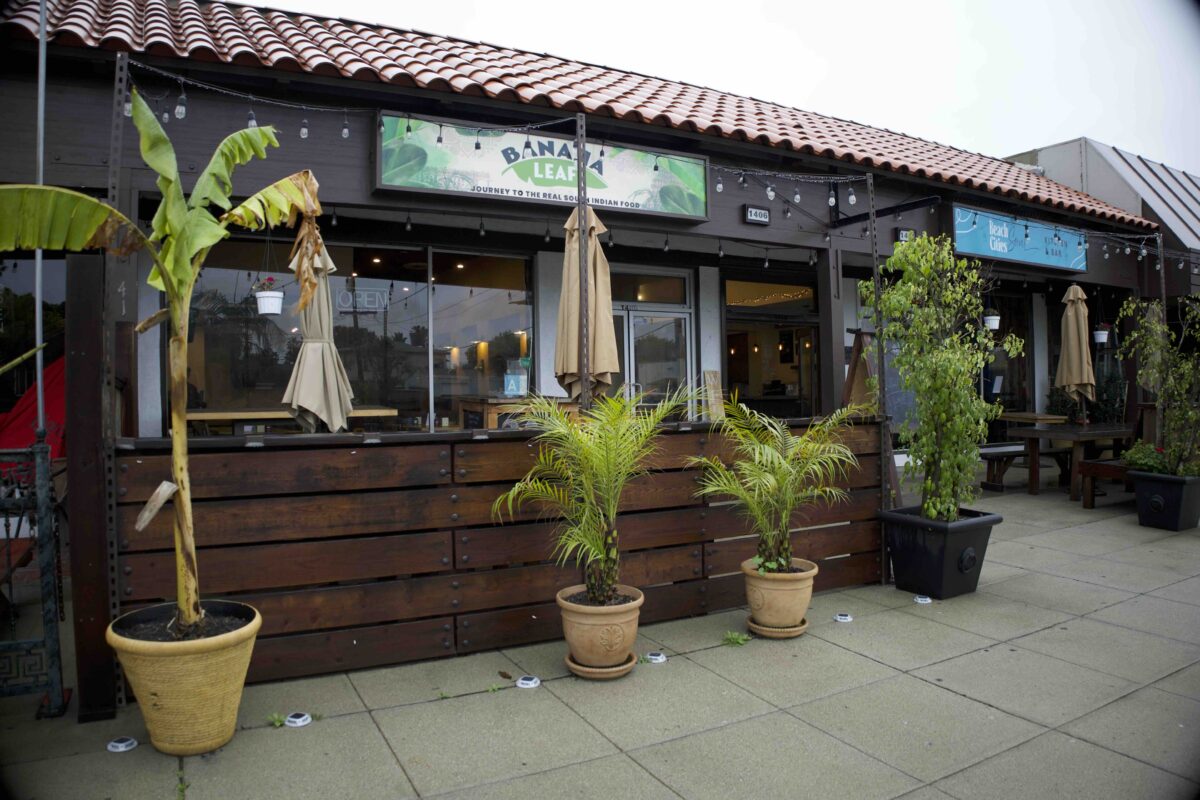Those who read my columns on a regular basis may have noticed I’m rarely the first to review a restaurant. This is deliberate, because as much as readers may want to know about a new eatery, what they’re doing the day they open may not reflect the long term experience. The chef may discover an item they love is too time-intensive for a rushed kitchen, or too weird or too pricey to catch on with their clientele. The servers have just met each other and the kitchen staff, and in the early days they’re more likely to fumble the handoffs. An early review is likely to be a hatchet job on a place that just needs time to find its groove.
One restaurant has been a special case, in that I have postponed a review three times. I was just about to write up Banana Leaf when they moved from South Redondo to a spot on Artesia. I was going to review that one when they moved back to a different location in South Redondo, and announced an ambitious new concept in which they would serve separate Indian and American menus. I went again and held off because while the food was very good, the rest of the experience was so chaotic that I figured that they needed more time to work it out. They still haven’t, but so many people have asked about the place that I’m not going to wait any longer.
The concept here was to offer South and Central Indian cuisine as Banana Leaf and American food as Beach Cities Social. The Western menu is dedicated to the late LA Times restaurant critic Barbara Hansen, who lauded the cuisine at the original Culver City location. Barbara was one of the few pre-Jonathan Gold mainstream critics who paid attention to “ethnic” cuisines, and I dined with her at that location once. Naming a fusion restaurant in her honor is an appropriate homage. Unfortunately, the Beach Cities Social menu is a halfhearted attempt to appeal to a non-Indian audience, offering a few rebranded Indian items alongside guacamole, a pair of salads, three sandwiches, kebab plates, and fries. That menu doesn’t appear on their website and isn’t given to diners unless they ask, and there is no sign advising that it’s available, so I wonder how often anyone orders from it.
The Indian offerings are more interesting, though the ordering process is complicated by the fact that there are three different menus, and when you are seated, they only give you one. After we had already figured out our order, we were handed a Blue Zoe menu and a “South Indian Specials” menu, both of which had some items that didn’t appear elsewhere. It’s weirdly and needlessly confusing. Anyone who is not already very familiar with Indian food will have to spend a lot of time with a search engine, no matter which menu they are looking at. Descriptions are nonexistent, so if you want to know the difference between a Konaseema shrimp curry and an Andhra shrimp curry, you need to ask. Some servers are better than others, but if you are in the room where they have live entertainment, you may not be able to hear the answer anyway.

Those who are either knowledgeable or adventurous will find a visit here rewarding, because the food is very good and the prices modest. We started our most recent meals with appetizers of samosa chaat, a naatu kodo dosa, chili paneer, and chicken 65. Chicken 65 is a modern Indian dish that was invented in 1965, anticipating the hot chicken craze by a few decades. If you like spicy and intensely flavorful fried chicken, this leaves the more one-dimensional Nashville version in the shade. The chili paneer is fried Indian cheese in a robust chili sauce, which doesn’t quite pack the heat of the chicken 65, but will delight vegetarians who enjoy robust, layered spiciness.
Our other two starters dialed down the temperature, but were no less interesting. Order samosa chaat and you’ll get a pair of potato and pea samosas that have been chopped and topped with garbanzo beans, sweet and minty chutneys, yogurt, and bits of cilantro. It’s a multi-textured and delicious mess, the chutney and yogurt cooling after one of the spicier dishes.
Dosas are crisp South Indian crepes made with a rice flour and yogurt batter. The one we ordered was stuffed with a gently sour chicken curry made with ginger, garlic, coconut flour, and tamarind. This looks like a skinny burrito about a foot and a half long. It’s served with a mildly nutty dipping sauce and a small bowl of sambar, the vegetarian soup of the region. Our server warned us that the chicken had bones, and we ate carefully but never detected any. I highly recommend this item, which is only listed on the “South Indian Specialties” menu.
Among the main dishes we tried were goat curry “rogan josh,” yellow mushroom curry, fish pulusu, mutton curry, stuffed tindora, and tamarind rice. Goat and mutton are very popular in Indian communities because the full-flavored meat pairs beautifully with hot spices, ginger, and garlic. If you have never tried or enjoyed either meat before, Banana Leaf is an excellent place to start. The rogan josh curry is based on tomatoes and had a slight smoky flavor and simmering but not fiery heat, while the goat was hot enough that our lips were tingling, but in a good way. Both have bones, so eat carefully, but if you’re adventurous do try them.

The eggplantcurry called gutti vankaya was warmly savory and somewhat mild, the fish tangy thanks to a curry that included balanced tamarind and chili flavor. On a separate meal we ordered an item made with tamarind, the pulihora rice. I had never previously had this rice is cooked in broth and mixed with cashews and cilantro, a winning combination. I hadn’t tried stuffed tindora either, and had no idea what they were until I looked them up. They’re a small gourd with a slightly bitter flavor, like a Chinese bitter melon but much milder. That gentle bitterness goes very well with stuffing that includes ground peanuts and dried coconut, and while I might not order this on every visit, I’d have it again.
The service and the kitchen timing on every visit was unfortunately less than assured. Despite the fact that the restaurant was nearly empty on our most recent visit, we waited a long time to order and the dishes dribbled out of the kitchen one at a time rather than together. One person seemed to be both serving and clearing the tables, while another staff member stood behind the bar doing nothing and a third staff member watched the people in the kitchen.
Many beers are available, as is wine, but we weren’t given a list so had to get up and look at the selection. I had wine while others in my party had masala chai and rosewater milk, both of which were a cooling antidote to the hotter dishes.
Banana Leaf is a project by restaurateur Sri Sambhaji, who owns five other Indian restaurants by the same name and is a partner in several fusion places. Despite the deficiencies in service and the challenge of ordering, I’ll probably return because I enjoy their food. The problems here can all be fixed, if only someone decides to do it.
Banana Leaf is at 1406 S. PCH in Redondo. Open 3 p.m. daily, close 10 p.m. Mo-Thu. Midnight Fr-Su. Patio or indoor dining. Parking lot in rear or street parking. Noise level soft when no live musicians playing.Check schedule. Many vegan items. Beer and wine. (424) 452-6070. BananaLeafla.com. ER









